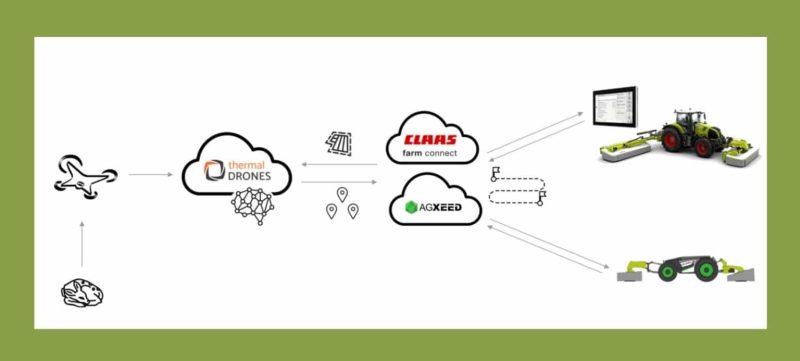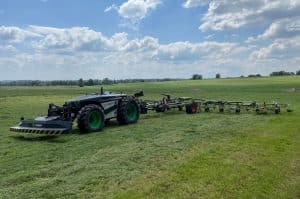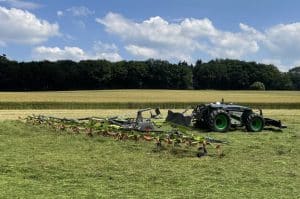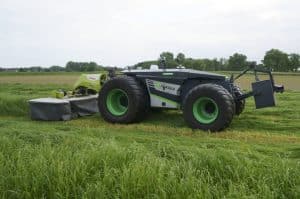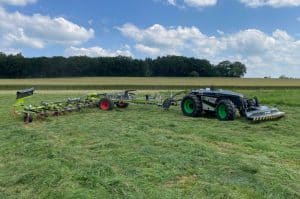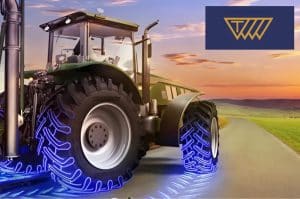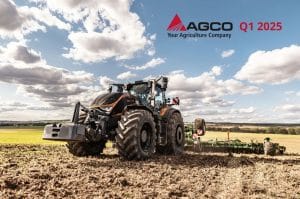CLAAS, AgXeed and thermal DRONES entered into a joint research project to combine wildlife rescue by drone with autonomous grass mowing. Another area of application in the forage harvesting chain is possibly the use of autonomous tractors and AgBots.
Harvesting green fodder is often labor-intensive, especially in early, high-yielding cuts. Before and during mowing, the areas must be searched or scanned for wild animals – and the operations of mowing, turning, raking and picking-up often take place in parallel. Autonomous tractors or AgBots can provide relief for many farms and contractors in the future. One challenge here is larger working widths, such as those of mower combinations, tedders or rakes, as these require a more comprehensive safety concept with more complex environmental monitoring and larger amounts of data to be processed.
Together with partners AgXeed and thermal DRONES, CLAAS is researching and testing various areas of application as a basis for further progress in development, standardization and legislation.
Protecting animals by drone
Drones with thermal imaging cameras are now a common, safe and effective way of tracking down nests and wild animals, especially fawns, shortly before mowing meadows or GPS stands. The search is usually carried out using a live image and is interrupted after scanning a heat source so that helpers can carry the animals out of the stand or mark locations and nests.
CLAAS, thermal DRONES and AgXeed have already pooled their expert knowledge and developed a common drone interface for autonomous mowing. Data from the heat sources identified during the drone flight is first stored, then processed using AI software and transmitted to the process planning tool together with the respective GPS position data. This tool incorporates the data into the route planning so that the autonomous mowing technology can be guided around the locations of the wild animals or nests while maintaining an adjustable safety zone. The bypass is used in particular on areas where there are protected nests that cannot be removed. Farmers and contractors can follow the use of machines live on their smartphone, tablet or PC via the AgXeed portal. In this way, the use of autonomous mowing teams not only meets the requirements for high area performance, but also for sustainable grassland management that protects wildlife. In addition, the farmer documents the measures taken before mowing and thus contributes to the obligation to provide evidence.
In the future, the technology will not only be usable with autonomous field robots, but also with autonomously driven tractors or tractors and harvesters that travel on previously planned routes with a driver and a steering system. The application will therefore be a useful customer solution in just a few years. It is ensured that the POI data of the wild animal and nesting sites are only collected within the known, previously determined field boundaries. The field boundaries can easily be taken from the farmer’s operational agricultural management system. If this data is not available, the drone pilot can mark the field boundaries himself on the display of his work screen.
Automation before autonomy
An AgXeed AgBot 2.055 W4 with a CLAAS VOLTO 1300 T tedder seems a good combination. “Thanks to job and lane planning, the use of the tedder is relatively easy to prepare, and the overview of the surroundings is very good thanks to the mown crop,” explains Philipp Kamps, Product Manager AGXEED. “Nevertheless, some work is still needed before the fully autonomous tedder with large working widths can be used commercially on a large scale. For this, the entire area in front of the implement must be secured with sensors.” Magnus Rupp, Project Manager CLAAS Saulgau, adds: “In order to achieve the goal of uncompromising work quality, complex automation of parameters such as driving speed and rotor speed as well as monitoring of the spreading pattern are also required, which currently does not allow for guaranteed economic use.”
Until then, further automated work and functional processes will be incorporated into the forage harvesting chain, thereby easing the burden on the driver. Some of these solutions are already available on the market.
Smart mowing
Another example is mowing with triple mower combinations. Thanks to the intelligent operating concept, both the operation of the front mower can be integrated into the ISOBUS of the rear butterfly combination, and the mower as a whole can be integrated into the tractor’s headland management system – depending on the driver’s preference. In addition, DISCO Business models offer unique comfort functions, such as the automatic belt acceleration BELT BOOST for clearing the belt units at the headland, the automatic reduction of the belt speed when lifting on one side and the automatic lifting of the mower units when switching to reverse. The optional CLAAS slope automation controls both the belt speed and the contact pressure when working on a side slope, thus ensuring the best swath formation and maximum protection of the turf while minimizing slope drift. In addition to lane planning and automated steering during mowing using the GPS PILOT CEMIS 1200 from CLAAS, another example is the Section Control function available for all LINER Business four-rotor rakes. This “digital revolution” enables a leap in operating comfort for the driver. With a daily output of 100 ha with an average field length of 250 m, the driver previously had to master up to 600 headland positions with raising, lowering or, at peak times, individual rotor lifting with great concentration. This work is now carried out by the electronics, which means considerable relief for the driver.
Standardization is teamwork
At the same time, CLAAS is working with partners on the further development of interfaces for the highly automated use of machines in the tractor or AgBot and attachment, as well as drone complex. The knowledge gained will then form the basis for the next step towards fully autonomous complex use without a driver. This topic has already been brought to the Agricultural Industry Electronics Foundation (AEF) via the ADVANCED AUTOMATION & AUTONOMY consortium (3A) and is being pushed forward there with great effort and with the involvement of other agricultural technology companies.

![RightSpot Ad Template Digital-1400×190-px[76] Ag Leader RightSpot](https://world-agritech.com/wp-content/uploads/elementor/thumbs/RightSpot-Ad-Template-Digital-1400x190-px76-r316mmc0hgoob9qxmklllnnbxta1nlj7t2vjkoyeek.png)


